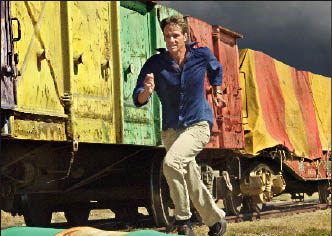Six Feet (Down) Under: Look Both Ways
by M. Faust

Very early on while I was watching the new Australian film Look Both Ways, I started noting comparisons to the HBO series Six Feet Under. The main character, Nick (William McInnes), is tall, lanky, a bit lantern-jawed, like SFU’s Nate. Both are runners; both have lived somewhat adventurous lives without learning much about themselves. Both came home for what was supposed to be a temporary visit due to the deaths of their fathers, but both stayed on. Most importantly, both the film and the series have the same central theme: death, grief and how we learn to deal with them.
For all I know SFU has never been shown in Australia, where this film’s debuting writer-director Sarah Watts has worked for years as an animator. And even if she did do some borrowing, there are worse sources she could have used.
Look Both Ways encompasses the experiences over a weekend of a half dozen or so characters linked mostly by their relation to Nick, but also by their reactions to a single event, the death of a man who was hit by a train.
Nick is a news photographer assigned to cover the story. His perception, shown in the shots he chooses, is affected by some news he has just received: He has advanced testicular cancer and has to wait three days for the lab results that will indicate his chances for survival.
Meryl (Justine Clarke) is a passerby he meets at the train site. An artist, she is also preoccupied with death, having just returned from the funeral of her father. She imagines the potentially fatal potential of every event she sees or story she hears (in bursts of animation). Maybe it’s the inappropriate timing that draw her and Nick closer together over the next few days in a relationship neither of them was looking for.
Also woven through the film are Nick’s friend Andy (Anthony Hayes), a reporter still suffering the pain of a bitter divorce; Anna (Lisa Flanagan), the girlfriend to whom Andy can’t quite commit; Nick’s editor Phil (Andrew S. Gilbert), the only one who knows of Nick’s illness, giving him a different perspective on his own life; and Julia (Daniela Farinacci), the dead man’s wife, who is understandably distraught by Andy’s published editorial asking whether her husband might have committed suicide.
There is also one other character, seen in silent vignettes interacting with his family, whose pain we don’t understand until late in the film with a scene that is touching in a most surprising way.
Despite a weakness for montages set to pop songs (there should be a limit of one of these per film), writer-director Watts keeps a firm grip on her film, which has a streak of dark Ozzie humor to keep it from getting morose. She makes the point that death is an inescapable part of life, and one that we need to learn to deal with sooner rather than later—a sentiment that sounds banal only until it touches you, even if vicariously, from watching a film.
|
Issue Navigation> Issue Index > v5n22: Summer Guide (6/1/06) > Six Feet (Down) Under: Look Both Ways This Week's Issue • Artvoice Daily • Artvoice TV • Events Calendar • Classifieds |









 Current Issue
Current Issue